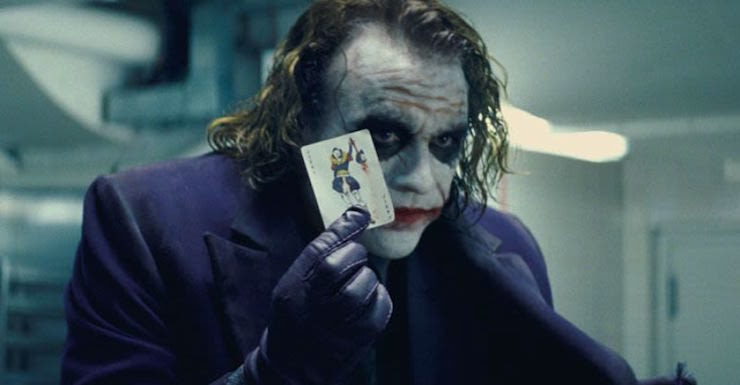David S. Goyer wrote a treatment for two followup films to Batman Begins, the first involving the Joker—as teased at the very end of the prior film—and the second involving Two-Face. Christopher Nolan and his brother Jonathan wound up condensing the two into one movie, which they called The Dark Knight. This was the first Batman movie not to have “Batman” in its title, though that particular phrase had eclipsed “the Caped Crusader” as the most common nickname associated with Bruce Wayne’s alter ego ever since Frank Miller & Klaus Janson’s landmark 1985 miniseries The Dark Knight Returns.
The movie was unfortunately marred by tragedy, as Heath Ledger died shortly after completing filming his role as the Joker.
Ledger’s death meant that all eyes were on this movie even more so than they would have been—and the scrutiny was already pretty intense. Batman Begins was a huge hit both financially and critically. Lots of people were looking to the sequel to match it, but were also gun-shy, given the diminishing returns of each of the sequels to the 1989 film, culminating in the mind-numbing horror of Batman & Robin.
Buy the Book
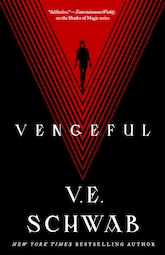

Vengeful
Adding a celebrity death to the mix just made the scrutiny sharper. So did the fact that the actor in question was playing a role that three great actors had already put their stamps on. Ledger not only had to live up to the expectations of the previous movie, but also the spectres of Cesar Romero in the Adam West TV series of the 1960s, Jack Nicholson in the 1989 film, and Mark Hamill’s voice in the 1990s animated series. (In your humble rewatcher’s opinion, Hamill’s voice remains the best interpretation of the Joker for the screen, with all due respect to Ledger’s performance and memory.)
Nolan dug deep into older Bat-comics for inspiration. One of the primary sources for the movie was Joker’s first appearances in Batman #1 from 1940, and Two-Face’s earliest appearances in Detective Comics #66, 68, and 80 from 1941 and 1943. Having said that, there’s a whole lot of the 1990s miniseries The Long Halloween here too.
Much of the cast from the first film returned: Christian Bale in the title role, Michael Caine as Alfred, Morgan Freeman as Fox, Cillian Murphy as Crane, and Gary Oldman as Gordon. Katie Holmes turned down reprising the role of Dawes, replaced by Maggie Gyllenhaal, and besides Ledger, the other primary antagonist is Aaron Eckhart, who starts out as a protagonist, new district attorney Harvey Dent. He is transformed into Two-Face part-way through the film.
“You wanna know how I got my scars?”
The Dark Knight
Written by David S. Goyer & Christopher Nolan and Jonathan Nolan
Directed by Christopher Nolan
Produced by Charles Roven and Emma Thomas and Christopher Nolan
Original release date: July 14, 2008
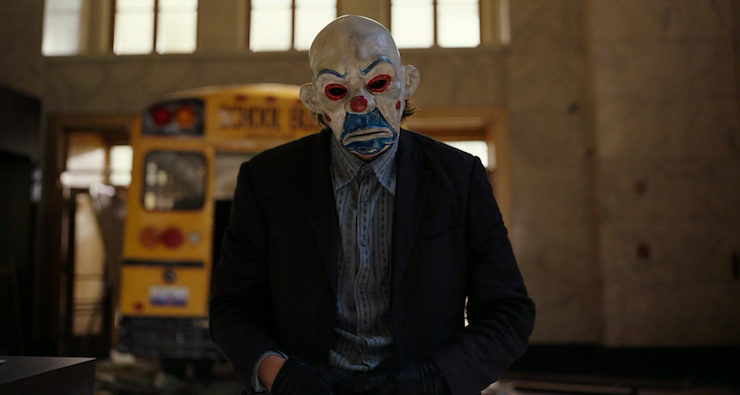
Five people in clown masks rob a bank. Two things are unusual about this heist: the guy in charge of intercepting the silent alarm is surprised to see that the alarm doesn’t call 911, but rather a private number; and the bank manager attacks the robbers with a shotgun. Turns out that this is a mob bank. In addition, each member of the gang has been instructed by the leader to shoot one of the other people when their job is done. In the end, there’s only one person left: the Joker.
It’s been the better part of a year since Batman Begins, and the few mobsters that are left have entrusted their cash to a Hong Kong businessman named Lau. Wayne Enterprises is also talking about a contract with Lau’s company, which Wayne has initiated solely so he can get a look at Lau’s (cooked) books. In addition, as Batman, Wayne has coordinated with Gordon—now in charge of the Major Crimes Unit, which has the least corrupt cops Gordon can find in it—to irradiate the money being used by the mobsters. They can now trace it to Lau. Realizing that the police are after him, Lau retreats to Hong Kong, where he is safe from extradition.
Lau has also hidden the rest of the criminals’ money—which, at this point, are the Italians (run by Sal Maroni with Falcone in Arkham), the Russians (run by Chechen, who enforces his will with nasty dogs), and the African-Americans (run by Gambol)—in a place he is keeping secret so nobody can give the location up. In the midst of the meeting where Lau explains this via videochat from his private plane, the Joker shows up. He kills one of Gambol’s thugs and stops anyone else from trying anything by showing them his jacket full of grenades.
Joker says that he has a better offer than “the TV set.” He will kill Batman, since he’s responsible for everything that’s gone wrong. He gives them time to think about it.

There’s a new District Attorney in Gotham, Harvey Dent. He’s charismatic, a former GPD cop in Internal Affairs, and dating Rachel Dawes. He’s also incorruptible, and he quickly carves out a reputation as a strong prosecutor. He also wants in on whatever Gordon and Batman have cooked up. Initially, Gordon doesn’t trust Dent—giving him the party line that the GPD abhors vigilantism (and the bat-signal is just a weird glitch in the floodlight on MCU’s roof)—but eventually, Gordon and Batman agree to let him into the treehouse, as it were.
Unfortunately, when they try to raid the remaining mob banks where Lau is keeping the money, they find only the irradiated bills. The rest of the cash has been removed. Gordon is convinced that there’s a mole in Dent’s office, since it didn’t leak until he found out about it.
Gambol puts out a bounty on the Joker, and some dudes bring Joker to him in a body bag. Joker climbs out of the bag and kills Gambol—after telling him a story of how he got his smile-like scars—and appropriates his gang.
Batman, Fox, and Alfred figure out a way to basically kidnap Lau out of his Hong Kong office and bring him to Gotham to be arrested. Fox leaves a cell phone in Lau’s office, which has been rigged to act almost like a sonar. Wayne—who has absconded with a ballet company and taken them on his yacht as cover for Wayne’s disappearance from the city, then gone from there to a black-market South Korean plane that flies under radar—uses that to track Lau and take him back to the States, leaving him on Gordon’s doorstep with a note.
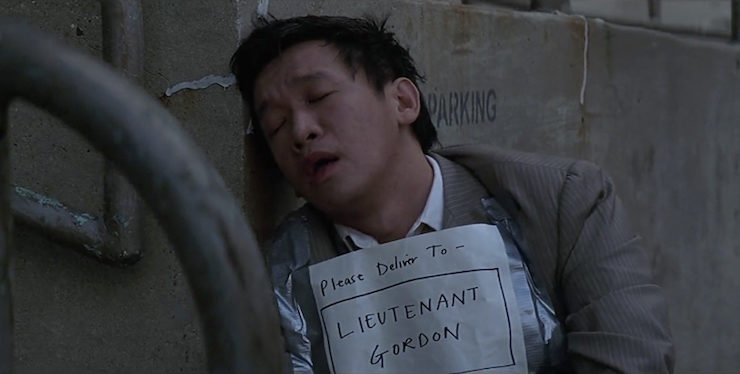
Dent and Dawes figure they can bring a RICO case against Lau, which means they can nail all the gangs—they wind up arresting dozens of people and indicting them all at once. It’s a show, and most of the higher-ups will be able to make bail and maybe even have the charges dropped, but the lower-level guys will plea bargain. Plus it sends a message that Dent is serious.
The Joker leaves three DNA traces on a Joker card that was found in the indictment of all the mobsters: Commissioner Loeb, Judge Surrillo (who’s presiding over the mob case), and Dent. Loeb is poisoned by his own Scotch, Surrillo’s car is blown up, and Joker himself tries to kill Dent at a fundraiser Wayne is holding for him to show his public support. (He also shows his private support to Dawes, letting her know that both Wayne and Batman support him, as it were.) Wayne puts Dent in a headlock and then in a closet to keep him safe, then changes to Batman to stop Joker from threatening the party guests. (While he’s changing clothes, Joker terrorizes the guests, including Dawes, whom he tells a different story about how he got his scars.)
Joker throws Dawes out a window, and Batman dives after her, saving her life, but allowing the Joker to get away. Still, Dent is saved. However, Joker’s next threat is to Mayor Garcia, and it almost works, as Joker comes very close to killing him while he’s delivering Loeb’s eulogy, but Gordon dives in front of the bullet.
After Joker announces that the killing will continue until Batman unmasks, Wayne decides to go ahead and admit who he is, after Alfred eliminates anything that will trace either Fox or Dawes to him. (Unbeknownst to Wayne, someone in the finance department named Reese has figured out that the Batmobile is Wayne tech. He goes to Fox demanding $10 million a year for the rest of his life. Fox reminds him that he’s blackmailing one of the wealthiest people in the world whom he believes to be a guy who beats the shit out of criminals every night, and is that really a good idea? Reese backs off.)
However, Dent cuts off Wayne’s sacrifice at the knees by saying that he is Batman. The GPD takes Dent into custody and he’s driven to prison in a huge convoy that is attacked by the Joker—and defended by the real Batman, and also Gordon, who faked his death to protect his family from Joker. In the end, after a lot of explosions and dead and maimed cops and civilians, Gordon and Batman manage to take Joker into custody.
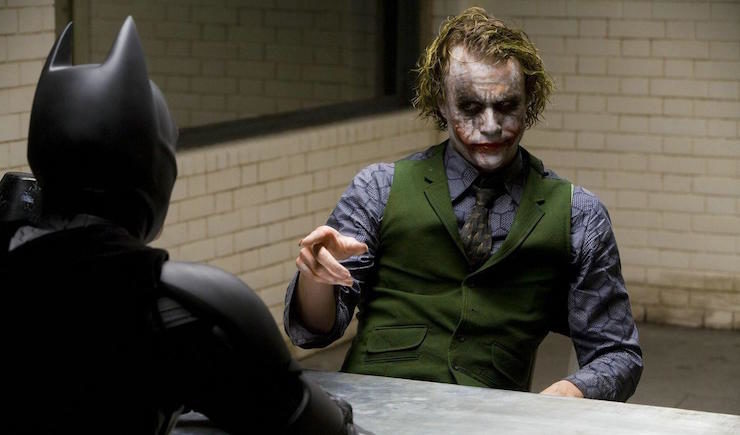
Dent goes off with one of Gordon’s detectives, and never arrives at his destination. Gordon and Batman question the Joker, and only from him do they discover that Dawes is also missing. He’s put them in two different locations; Batman immediately goes to where he said Dawes is (Joker figured out that he’s sweet on her based on how quickly he leapt to her rescue) while Gordon takes a task force to where he said Dent is.
But, of course, the Joker lied. Dawes is where the cops go, and Batman goes to Dent. Both are tied up in a room filled with oil barrels. In his attempts to escape, Dent falls on the floor on his side and spills one of the barrels, covering the left side of his face in oil. Batman manages to get Dent out before Joker detonates the oil, but the left side of his face catches fire.
Gordon does not get to Dawes in time, and she’s killed.
Both Dent and Wayne are devastated. Dent refuses plastic surgery or even painkillers to deal with the scarred side of his face. His two-headed coin—which he’s used several times to pretend to flip a coin without revealing that it was two-headed—is now scarred on one side also.
Dawes left a note with Alfred to give to Wayne when the time was right. Even though she had promised that she’d wait for him to stop being Batman before she could love him properly, her heart now belongs to Dent, and she says in her note that she’s going to marry the DA. In fact, her last word to Dent was, “Yes.”
While large numbers of cops and Batman are busy rescuing Dent and Dawes, Joker manages to break out, killing several cops and also taking Lau with him.
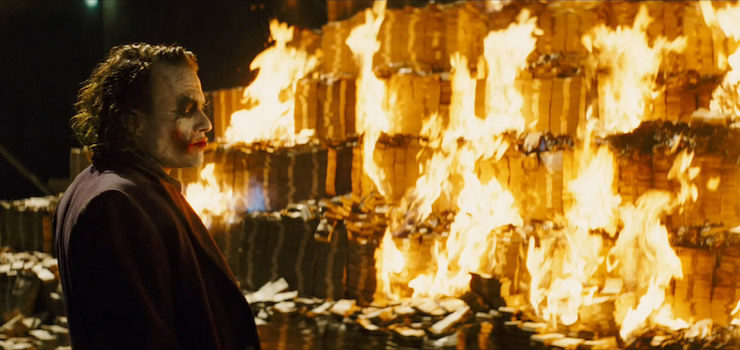
In light of all this stuff happening, Reese decides to go public with his belief that Wayne is Batman. Before he can go on TV to do so, Joker announces that he doesn’t want the world to know who Batman is, so he threatens to destroy a hospital unless Reese is killed in an hour. Gordon and Wayne are able to stop two attempts on Reese’s life, and Joker does destroy a hospital, though not until after it’s evacuated. Joker confronts Dent in the latter’s hospital room before he blows the place up, and actually gives Dent a gun and puts it at his own head. Joker goes on about how he’s an agent of chaos because chaos is completely fair. Dent feels the only fairness is the flip of a coin, and it’s on that basis that he decides whether or not to take up Joker on his offer to shoot him.
It comes up the unscarred side, so Joker lives, and Dent escapes before the hospital blows up. Joker takes one of the buses with the evacuated patients and absconds with it. Dent goes to the cop who took him to the warehouse and kills him (the coin came scarred-side-up), but he doesn’t reveal who the other dirty cop is. So Dent goes to Maroni, who tells him it’s Ramirez. The coin comes up unscarred for Maroni, so he lives—but the driver isn’t so lucky…
Dent gets Ramirez to convince Barbara Gordon and her kids to leave her house, saying the cops guarding her aren’t trustworthy. Dent then takes Gordon’s wife and children to the same spot where Dawes died.
Wayne has created a device that can do on a larger scale what Fox did in Hong Kong, using everyone‘s cell phone as a microphone to create a sonar field. Fox is appalled, as this is unethical and a huge violation of privacy—which is why Batman has encoded it so that only Fox can use it. He’s only using it to track the Joker, and when that’s done, Batman tells him to enter his name.
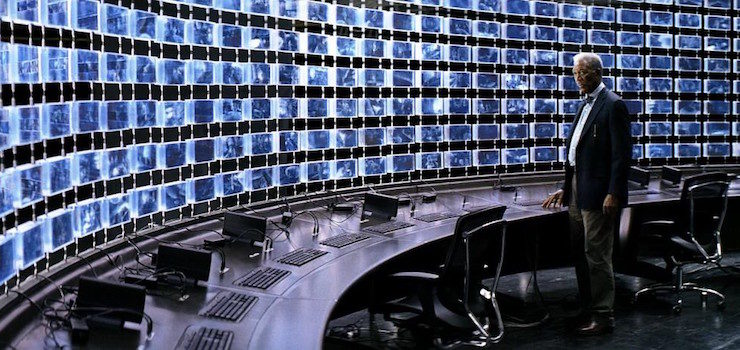
Joker has made threats to the “bridge and tunnel” crowd, and scared the populace into a panic. Two ferries are taking people out of the city, one with regular citizens, one with prisoners being moved out of harm’s way. Both ferries go dark, and the crews discover that they both have explosives in the engine room. Each ship has a detonator that will blow up the other ferry. If one chooses to blow up the other boat, it’ll be spared, but if nobody chooses by midnight, both boats will be destroyed.
The civilian ferry argue over it and eventually decide to put it to a vote. It’s overwhelmingly in favor of detonating the other boat. But when it comes time to do it, nobody can press the button—not even the biggest agitator, who gets all macho until he actually has the detonator in hand.
One of the prisoners goes to the head of the guards in charge and tells him that he needs to take the detonator and “do what you shoulda did ten minutes ago.” The prisoner takes the detonator and throws it out the window.
Fox has traced Joker to an under-construction building. The hostages are there, along with his thugs—but the people in clown outfits holding guns are the hostages, the guns duct-taped to their hands and their faces hidden. Joker’s thugs are all wearing scrubs with their weapons hidden. Batman figures this out, and has to actually fight the SWAT units before they kill innocent civilians (whom they will think are bad guys who won’t drop their guns).
Batman and Joker then confront each other, and Batman stops him from detonating the ferries. When it’s over, Fox enters his name, and the entire sonar setup self-destructs.
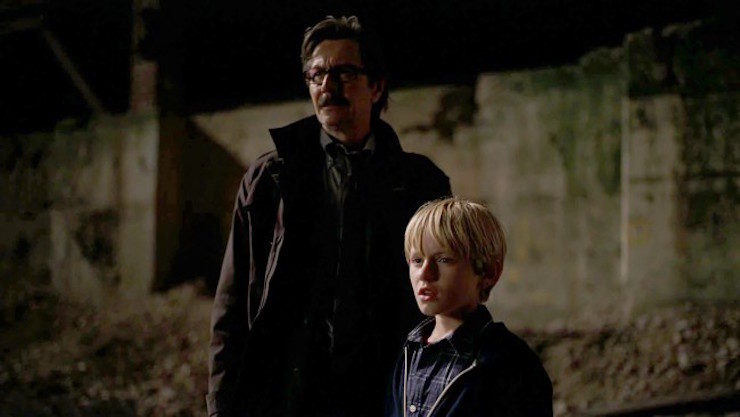
But Joker is only half the problem. Dent has taken Gordon’s family hostage. Gordon tries to get Dent to set them free, as does Batman when he arrives, but he insists on using the coin to determine their fate. Batman tackles him before the coin can fall to determine Gordon’s son’s fate, and Batman manages to save the boy. Dent falls to his death, and Batman is pretty badly hurt.
In order to save Dent’s reputation, Batman tells Gordon to blame him for everything Dent did, including the deaths of Maroni, his driver, and two cops. They need Dent’s reputation to remain untarnished, otherwise Joker wins. Batman can take the hit—Gotham can’t.
“I’m an agent of chaos”
Up front let me say that The Dark Knight is, in my opinion, one of the best adaptations of a comic book ever done. There are a number of reasons for this.
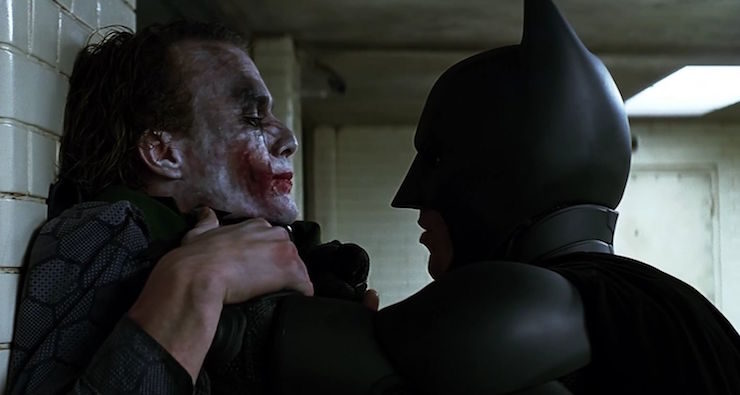
For starters, this movie isn’t about Batman, it isn’t about the Joker, it isn’t about Harvey Dent or Jim Gordon—it’s about Gotham City. It reminds me a lot of The Wire—one of the three or four finest TV shows in the history of the medium—which isn’t really about any single person, but is instead about Baltimore. This is about Gotham, and how it is trying to crawl out of the depths of the previous movie, which was so bad that Ra’s al-Ghul wanted to blow it up rather than try to save it. Between Gordon and his less corruptible MCU (though not as incorruptible as Gordon himself might have hoped), Batman and his war on the criminal element, and prosecutors like Dent and Dawes, there’s actual hope in Gotham.
Into this comes the Joker, who is a self-stated agent of chaos. He does everything he can to stir the pot, from messing with the money made from criminality to threatening, and sometimes taking, the lives of prominent citizens to generally making people paranoid and scared. He’s a nihilist, with no desire to actually kill Batman, nor to accumulate wealth (he burns most of the money he gets from Lau), just to bring on the crazy.
Ledger’s Joker is a fascinating characterization—less completely batshit than the Nicholson or Hamill versions, not as goofy as Romero, and in many ways closer to the 1940s version of the character, albeit a 21st-century interpretation of that version. But he’s less a character than he is a force of nature, which is why I ultimately think he’s not the most interesting person in the movie. He’s a living catalyst, but he’s not actually a character.
No, the antagonist that makes my skin crawl, the one that I find frightening and effective isn’t the agent of chaos, it’s the hero who is destroyed and broken down and turned into a villain. Two-Face has always been one of Batman’s most fascinating villains, and he’s generally done right by here, though the story keeps the villain from attaining his true potential as a foe for Batman. Having said that, the story does do the most important part, which is the tragedy of Dent’s existence, which has been the heart of the character for seven decades. Eckhart gives the performance of a lifetime here, giving us Dent’s heroism, his passion, his anger—we see his dark side long before the explosion that destroys half his face. And we see how he’s utterly broken, not just by the explosion, but by losing Dawes. Gotham’s white knight has been corrupted utterly, turned into a murderer, the perfect embodiment of Joker’s corrupting influence.
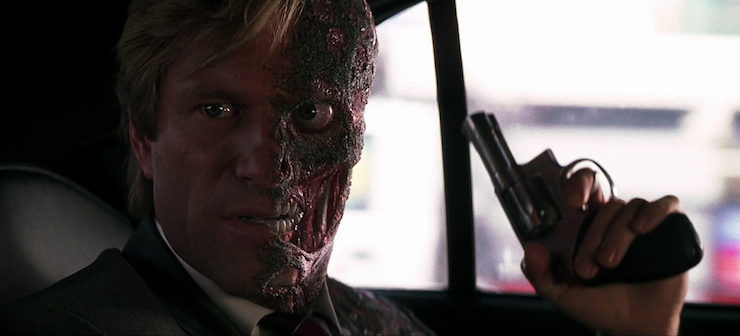
But it’s not universal. There’s a lot of talk of heroism in this movie, with Batman insisting that he’s not a hero, and Gordon agreeing with him, saying that instead he’s a guardian—and maybe he is, maybe he isn’t. These three movies in general and this movie in particular tries to look at Batman-as-hero from many different angles. However, he’s not the biggest hero in the movie. That distinction goes jointly to the prisoner and the civilian passenger who choose not to blow up their fellows. And yes, the asshole who changes his mind is a hero because he thought it through. He recognized what responsibility he had taken on, to kill a boatful of people. Yes, most of them were criminals (though there were also guards and cops on board, not to mention the boat’s crew). But he would not kill them. And the prisoner who unhesitatingly tossed the detonator in one of the great misdirect scenes of all time was an even bigger hero because he knew the score. Both boats agreed that the prisoners “deserved” to die more, but the truth is that nobody deserves to die, and death is something that should be put off as long as possible, because you can’t take it back. That’s why Batman won’t kill—a rule that Nolan mercifully keeps intact, to the point that Batman is thrice tempted to kill Joker but refuses.
There are a lot of great performances here, but the ones that left me flattest are the two leads. Christian Bale’s performance is still all surface, though he has some excellent moments, particularly with Michael Caine’s Alfred. (“I suppose they’ll lock me up as well, as your accomplice.” “Accomplice? I’m going to tell them it was all your idea…”) Ledger is much the same—but then that’s actually fitting for their places in this film, because they’re both extreme symbols, Batman of order, the Joker of chaos. They’re not characters, they’re living archetypes. It’s left to Gordon and Dent and Dawes and the cops and the criminals and the rest to be the actual people affected by the conflict between Batman’s attempt to bring order to the cesspool of Gotham and Joker’s attempt to tear it all back down again.
Gary Oldman mumbles a bit too much, but his performance is earnest and heartfelt as he tries to hold together a corrupt police force with both hands. Maggie Gyllenhaal purses her lips a lot as Dawes, but she’s actually less interesting than Katie Holmes was in the previous film—though that’s more the fault of the script, as Dawes’s purpose in this film is to be The Dual Love Interest, and it’s spectacularly uninteresting. She’s also the only female speaking part of consequence aside from Detective Ramirez, presented as one of Gordon’s good cops, but who turns out to be one of the dirty ones. And then Dawes gets fridged so that Dent can become Two-Face. Sigh. Morgan Freeman is Morgan bloody Freeman, while Aaron Eckhart just knocks it out of the park.
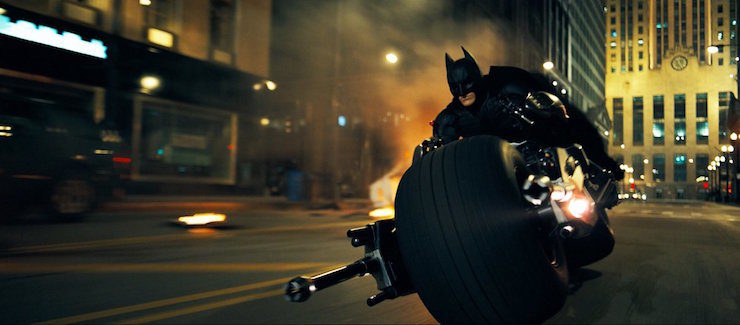
What’s best about this movie, though, and why I admire it above almost all others I have done or will do in this rewatch, is that it’s the perfect adaptation of a standard superhero comic. Far too often, movie adaptations will either change the source material so much that it’s unrecognizable, or they’ll do an origin story or they’ll do something that utterly shatters the status quo. It’s very rare to find a superhero movie that just tells the latest in the ongoing adventures of the hero(es), even though that’s what makes up 99.9% of all superhero comics, and rarer still to find such a story that is actually any good. (I mean, to give two examples, Thor: Dark World and Superman III were like that, but they were not great. Ditto Joel Schumacher’s two Bat-films in the 1990s.) But when it works, it works spectacularly well (e.g., Spider-Man: Homecoming), and it’s what these movies should be more often than not. The Dark Knight is the only one of Nolan’s trilogy that is like that, because it’s telling the middle of Batman’s career, with Begins covering the beginning of it (obviously) and The Dark Knight Rises (which we’ll cover next week) covering the end of it.
It’s also by far the best of Nolan’s trilogy at least in part because of that. This is a pure Batman adventure, and it’s also a really really really good Batman adventure.
Nolan got to finish the trilogy four years later. Next week, we’ll take a gander at The Dark Knight Rises.
Keith R.A. DeCandido will be a guest at Shore Leave 40 in Cockeysville, Maryland, just north of Baltimore, this weekend. Other guests include actors William Shatner, Ming-Na Wen, Alison Scagliotti, Shawn Ashmore, Peter Williams, Peter Kelamis, Aron Eisenberg, and Chase Masterson; fellow authors Christopher L. Bennett, Greg Cox, Peter David, Mary Fan, Michael Jan Friedman, David Mack, Mike & Denise Okuda, Hildy Silverman, Dayton Ward, Howard Weinstein, and tons more; plus science, performing, and arts guests. Keith will be there both as an author and a musician, as his band Boogie Knights will be performing Saturday morning and as the masquerade halftime. Get his full schedule here.










